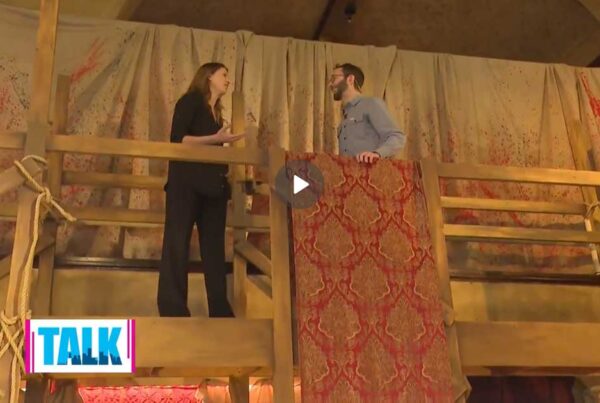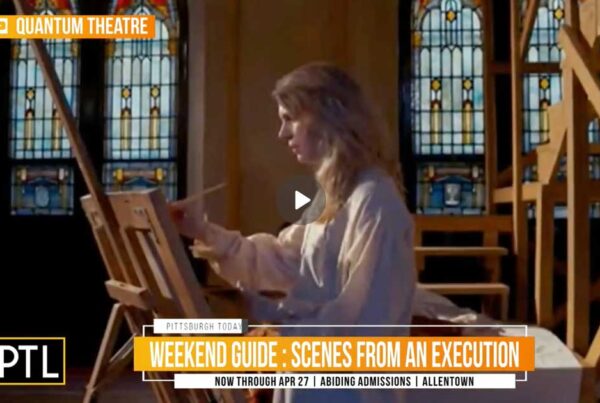Pittsburgh Post-Gazette – It’s a mystery, or rather, several. A biography, or maybe three. A romantic narrative. A workout!
It’s Quantum Theatre’s multidimensional, sometimes daunting new “Chatterton,” a play by Karla Boos now having its world premiere among the sanctuaries, stalls, halls, balconies and hideaways of Trinity Cathedral, Downtown.
The short, extraordinary and controversial life of Thomas Chatterton (1752-1770) forms the narrative spine, and that contains mystery enough, starting with his precocious poetic genius and not ending with his death at 17. In those few years he created persuasive works by an invented medieval monk, imitated the works of others and poured out reams of poetry and journalism of his own.
But the mystery of Chatterton didn’t end with his youthful death in dubious circumstances, because he was resurrected by later poets as a proto-Romantic (Wordsworth, Coleridge, Keats, they all wrote about him) and then idealized as a victim of poverty and class snobbery. He was immortalized 86 years later in a famed painting imagining his death, scholars argue over him still and Peter Ackroyd achieved a hit with a 1986 book, “Chatterton,” on which this play is based.
Following Mr. Ackroyd, Ms. Boos, Quantum’s indefatigable artistic director, layers the poet’s story with that of imagined modern writers, Charles Wychwood (lots of puns in that) and Harriet Scope, and the painter of the 19th century painting, Henry Wallis and his model, famed author George Meredith.
And then the ingenious Quantum travel agents send the audience off on three tracks, following different characters into different spaces in the cathedral to watch different scenes, sometimes overlapping, sometimes catching a bit of this and a soupcon of that. You do a lot of walking. In the intermission, they feed you a very good meal and you can share understanding and confusion with others. It’s a complex plan such that you would need to go three times to see every scene.
You’d still be left with questions. That’s the point. I’ve been twice, taking two of the three tracks, and while I have assembled many pieces of the puzzle, I can see that it will remain multidimensional and beyond complete grasp. Because who can know the complete truth of Chatterton’s life (even though Ms. Boos does take a stand on his death). And who can truly know all the motives of the 19th century Wallis and Meredith or contemporary Wychwood and Scrope?
But ultimately, this “Chatterton” aspires to be more than a mystery, biography or narrative, but an active interrogation of overlapping issues. Influence, adaptation, imitation, parody, plagiarism, piracy and forgery — where does one end and another begin? Where does borrowing shade into admiring appropriation, or fresh invention justify theft? Does genius forgive any transgression?
Ask Shakespeare about that.
How fitting that a play about adaptation and its many relatives is itself an adaptation by Ms. Boos of Mr. Ackroyd. How appropriate that we are challenged to sort out its pieces, both invented and “true.” And how wonderful that we do so amid the spaces of a gothic cathedral, itself a modern adaptation of a much older architectural mode.
For some, the physical spaces of Trinity Cathedral will be the best part of the experience, especially as dressed by scenic designer Stephanie Mayer-Staley. Savor as much of her small detail as you can. C. Todd Brown’s lights add richness, and District 5 Sound deals bravely with the challenges of space. (If you can’t hear everything, just relax and go with it.) Joe Seamans adds projections that suggest other dimensions of feeling or place, and Robert C.T. Steele’s costumes are sumptuously in period.
There ought to be a whole paragraph here about the technicians involved. And the meal is an attraction in itself. My two visits were the same weekend, so I was fed twice by Kate Romane. Bill Fuller handled weekend two, and there are five more chefs to come.
At the heart of the story is Jonathan Visser’s Chatterton, a commanding figure on whom to build a play, doubtless taller and older than the real man, but suggesting all his enigma and frustrated talent. Tony Bingham’s Wychwood is the sympathetic hero of the contemporary story and Helena Ruoti’s schemer, Scrope, is his deliciously comic antagonist.
They are the central figures of the three different tracks. Each, you will notice as you struggle with the puzzle, is to some extent defined by or obsessed with death. Ending up more happily are the two characters played by Martin Giles, both eventually married to women played by Gayle Pazerski. Giles is also credited as contributing writing and dramaturgy.
Six other actors (but it seems like many more) play a variety of roles with relish. I particularly enjoyed Alan Stanford’s sardonic art dealer, Tim McGeever’s insolent Merk, Jeff Monahan’s florid Joynson and Ken Bolden as his angry partner, Pat — and each of them enjoyed these roles at least as much.
If you’re going once, you ask, which track should you take? Well, don’t go once. But otherwise, I don’t think it matters: you’ll still be left with both insights and questions, as the play requires.
How to describe let alone assess the work of Ms. Boos as both writer and director? “Chatterton” has narrative drive, flashes of beauty and surprising insights, as well as odd detours and loose ends. There are ways it falls short of what it attempts. But to focus on those is more like carping than true criticism. With apologies to Robert Browning, “a theater’s reach should exceed its grasp, or what is Quantum for?”




